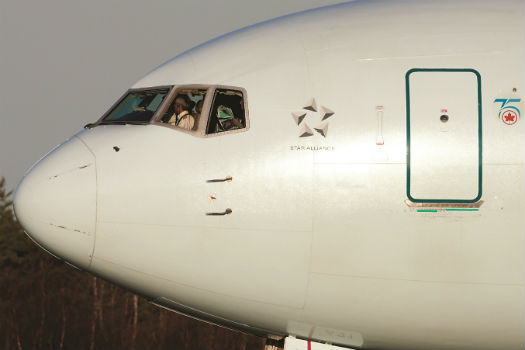Estimated reading time 6 minutes, 24 seconds.
Transport Canada aims to introduce changes to flight and duty time regulations in two phases, with 705 airline operators being the first group affected. Michael Durning Photo
Controversial changes to Canada’s flight crew fatigue management regulations may be delayed until after the 2015 federal election.
After issuing a notice of proposed amendment (NPA) for flight and duty time regulations in September 2014, Transport Canada was expected to publish a final proposed rule in the Canada Gazette, Part I, this summer.
Instead, in early August, Transport Canada took the unusual step of publishing a notice of intent (NOI) to amend the Canadian Aviation Regulations (CARs) to address flight crew fatigue management, indicating that changes to the flight and duty time regulations will be introduced in two phases. Phase 1 will apply to CARs Subpart 705 airline operators, while Phase 2, “to be introduced as soon as possible as part of a future regulatory proposal,” will apply to all air operators.
At press time, the full implications of the NOI were unclear. What was clear was that Transport Canada’s action would further delay a rulemaking process that has been underway since 2010.
“It has been very frustrating to say the least,” stated Capt. Ian Smith, president of the Air Canada Pilots Association (ACPA), in a press release issued shortly after publication of the NOI. “It is essential that Canada upgrade its safety regulations in order to meet the global standards stipulated by the International Civil Aviation Organization (ICAO). We were hoping to have the new regulations in effect by 2015, but with the latest NOI, it looks like action is still years away.”
Not everyone sees that as a bad thing, however. The effort to update Canada’s flight and duty time regulations has been contentious since the process began, five years ago, with a working group struck by the Canadian Aviation Regulation Advisory Council (CARAC) Technical Committee. After the working group co-chairs issued their final report in August 2012, industry associations representing aerial work, air taxi and commuter operators issued a lengthy joint dissent, describing the report’s recommendations as a “one-size-fits-all” approach that had the potential to devastate many sectors of the Canadian aviation industry.
Nevertheless, the CARAC Technical Committee endorsed the report and handed it off to the Civil Aviation Regulatory Committee. Nearly three years later, most of the report’s recommendations appeared in Transport Canada’s September 2014 NPA, which was issued without further consultation with industry — leaving many people feeling “blindsided,” according to Helicopter Association of Canada (HAC) president Fred Jones. “After almost three years of deafening silence since the CARAC process was completed, and on 48 hours notice, the Department issued an NPA and gave the industry two weeks to comment,” said Jones. HAC was one of a dozen industry associations that quickly mobilized in opposition to the NPA, appealing directly to Minister of Transport Lisa Raitt with their concerns, and organizing a grassroots advocacy campaign among their members.
“The entire community of commercial aviation opera¬tors came together, and it made for a very powerful statement. We know that was effective,” said Jones.
The associations would like to see Transport Canada adopt sector-specific solutions that take into account the unique operating environments of CARs Subparts 702, 703 and 704 operators. Although it remains to be seen whether Transport Canada has “bought into the concept that different industry segments require different fatigue regulations,” Jones said, the associations are pleased to see that Transport Canada is addressing only airline operators for now.
According to the NOI, the Phase 1 proposed regulatory amendment would reduce the annual flight time limitation for Subpart 705 operations to 1,000 hours in 365 days, and the daily flight duty time limitation to between nine to 13 hours, depending upon the start time of the flight duty and the number of segments of the flight. Flight crewmembers would be afforded a minimum rest period of 10 consecutive hours, plus travel time and time for meals and hygiene.
The current requirement for time free from duty would also be modified to 33 consecutive hours free in 168 consecutive hours, in which the time free from duty would begin no later than 22:30 and end no earlier than 07:30 on the second subsequent morning. And, the proposed amendment would introduce the concept of a voluntary Fatigue Risk Management System (FRMS), which would allow operators with an FRMS in place to extend the maximum flight duty period per flight schedule by one hour.
The NOI does not give a timeline for the Phase 1 proposed regulatory amendment, but many observers, including Jones, would be surprised to see it published before the Oct. 19, 2015, federal election. “There is always an extremely heightened sensitivity running up to any federal election,” Jones observed.
As for Phase 2, he said, “time will tell”—but he doesn’t expect the aviation industry to be blindsided again to the same extent. Having united over the past year in opposition to the NPA, HAC and other industry associations have developed a level of “trust and solidarity” that should facilitate continued cooperation on the subject, he said. “As painful as it was, the avia¬tion community will be better prepared for whatever [Transport Canada does] in the next step.”

